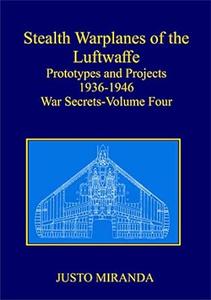
Free Download Stealth Warplanes of the Luftwaffe: Prototypes and Projects 1936-1946
by Justo Miranda
English | 2022 | ASIN: B0BKB1PXSK | 130 Pages | AZW3 | 6.37 MB
Flying wings are inherently stealthy in nature because of their low radar cross section and able to pass through the 20-50 MHz radar defenses of the British Chain Home.
One might speculate that Germans discovered the Stealth effect by chance, associated to the flying wings. Perhaps due to an unusual Freya contact or from a confidential report of Dynamit AG Troisdorff, after analysing the inner structure of the Horten Va, a flying wing entirely built of synthetic material.
Perhaps Göring saw this technology the weapon that would allow the negotiation of an honourable peace, as that of 1918. A similar advantage to that obtained with the Stuka in 1939 or with the Window in 1943.
When the Stealth properties of flying wings were discovered, a new concept of 'unstoppable' bomber was born. Their manufacturing did not require the use of strategic materials, and in the future, it would not be necessary to have great fleets of bombers built of aluminum that would make massive attacks at the cost of great losses, like in 1940. A reduced number of flying wings, equipped with the most advanced navigation devices, could do the work without losing dozens of well-trained crew members in each raid. Besides, the flying wings could transport more weight of weapons and fuel at a greater distance than the conventional airplanes, given their large wing surface and low drag.
In autumn 1944, after a series of conferences organized by Göring between representatives of the aeronautical industry, the Oberkommando der Luftwaffe (OKL) published three specifications directed towards the building of Stealth bombers.
The first one was the "1000x1000x1000" specification required a twin jet Schnellbomber (fast bomber) able to pass through the British radar defenses with a load of 1,000 kg of bombs, a penetration depth of 1,000 km (one third of the operational range) and a speed of 1,000 km/h at operational altitude.
The second one was a four-jet engine airplane of the Uralbomber category. The requirement was for a range of 5,000 km, a maximum speed of 800/900 km/h and a payload of 4,000 kg.
The third one was an intercontinental Amerikabomber of 11,000 km range. It was a flying wing with a span of 40 m, powered by six Jumo 004B turbojets and designed to launch a bomb of 1,000 kg over New York or Washington, with impunity, operating from bases in Germany.
